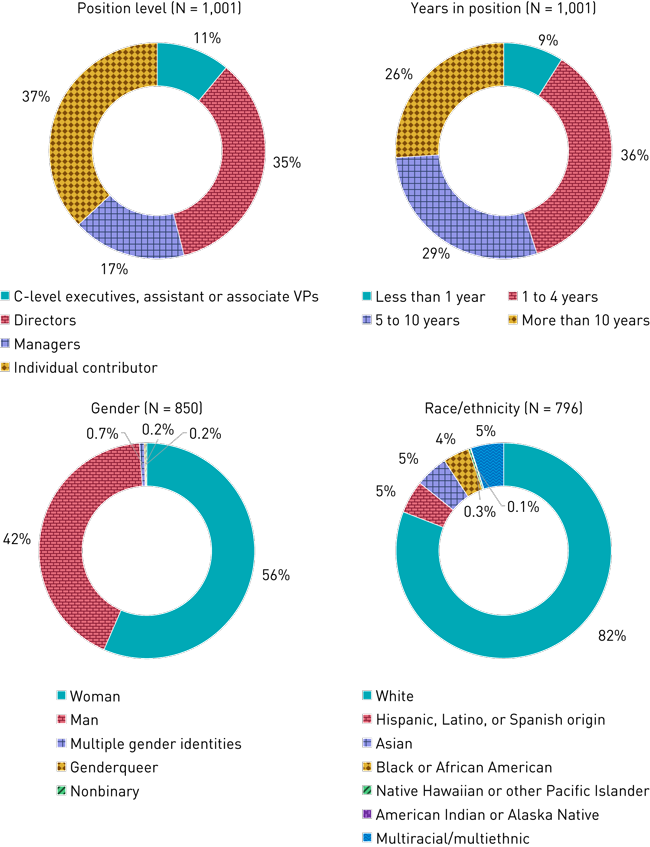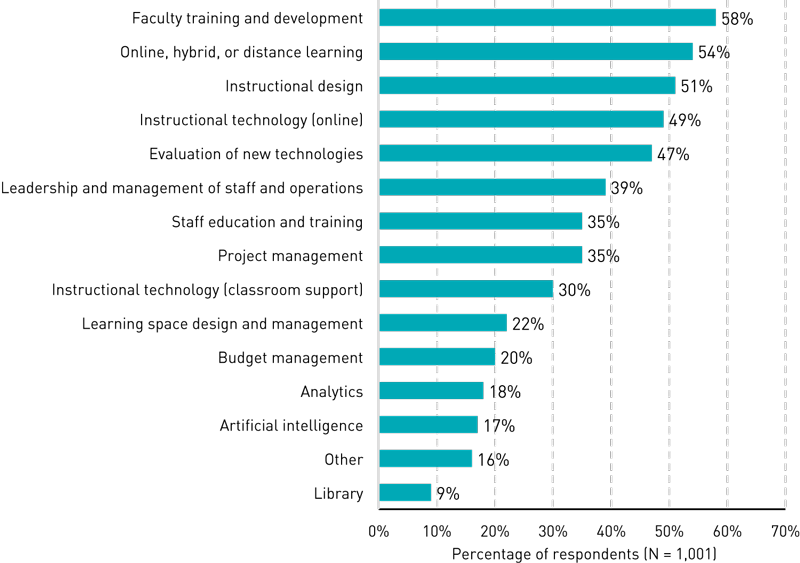Respondent Composition
Respondents varied in position level, years of experience, gender, and age. Over a third of respondents were individual contributors (37%), followed by directors (35%), managers (17%), and C-level executives and assistant or associate vice presidents (11%) (see figure 1). A large majority of respondents (91%) had been in their current position for at least one year, with over half (55%) having been in their positions for five or more years. A slight majority of respondents (56%) were cis-female, followed by cis-male (42%), and most respondents were white (82%). Respondents varied in age (26 to 77), with the average age being 51.

The most common areas of responsibility were directly related to instruction. The three most common areas of responsibility were faculty training and development (58%), online, hybrid, or distance learning (54%), and instructional design (51%) (see figure 2). The least common area of responsibility was library (9%), followed by those who selected "other" areas of responsibility (16%). Those who selected "other" reported responsibilities in the areas of faculty (teaching/research), IT, accessibility, assessment and institutional research, student support, course materials, and alternative education. However, each of these areas was only selected by a very small percentage of respondents (less than 4% for each); therefore, we keep these individuals grouped together in the "other" category for the remainder of the report.

Most respondents have multiple primary areas of responsibility. A majority of respondents (85%) indicated that they have more than one primary area of responsibility. Of these, 65% reported having between two and seven areas of responsibility. Since most respondents reported multiple areas of responsibility, we examined what responsibilities were most common for each area. Figure 3 is an interactive table that displays the three most common additional responsibilities by area. Most notably, across all 15 areas of responsibilities, faculty training and development emerged as one of the top three additional areas of responsibility, while online, hybrid, and distance learning emerged in the top three for 10 areas, and evaluation of new technologies emerged in the top three for 8 areas.
| 71% also have responsibilities in evaluation of new technologies |
| 63% also have responsibilities in faculty training and development |
| 60% also have responsibilities in online, hybrid, or distance learning |
| 81% also have responsibilities in evaluation of new technologies |
| 76% also have responsibilities in online, hybrid, or distance learning |
| 74% also have responsibilities in faculty training and development |
| 85% also have responsibilities in leadership and management |
| 73% also have responsibilities in evaluation of new technologies |
| 65% also have responsibilities in faculty training and development |
| 71% also have responsibilities in faculty training and development |
| 70% also have responsibilities in instructional technology (online) |
| 65% also have responsibilities in online, hybrid, and distance learning |
| 70% also have responsibilities in instructional design |
| 67% also have responsibilities in online, hybrid, and distance learning |
| 64% also have responsibilities in instructional technology (online) |
| 80% also have responsibilities in faculty training and development |
| 77% also have responsibilities in online, hybrid, and distance learning |
| 72% also have responsibilities in instructional technology (online) |
| 76% also have responsibilities in faculty training and development |
| 76% also have responsibilities in online, hybrid, and distance learning |
| 74% also have responsibilities in instructional design |
| 74% also have responsibilities in instructional technology (online) |
| 72% also have responsibilities in evaluation of new technologies |
| 70% also have responsibilities in faculty training and development |
| 64% also have responsibilities in evaluation of new technologies |
| 61% also have responsibilities in faculty training and development |
| 57% also have responsibilities in online, hybrid and distance learning |
| 78% also have responsibilities in evaluation of new technologies |
| 72% also have responsibilities in faculty training and development |
| 68% also have responsibilities in online, hybrid, and distance learning |
| 48% also have responsibilities in faculty training and development |
| 47% also have responsibilities in evaluation of new technologies |
| 46% also have responsibilities in leadership and management |
| 73% also have responsibilities in faculty training and development |
| 72% also have responsibilities in instructional design |
| 69% also have responsibilities in instructional technology (online) |
| 66% also have responsibilities in evaluation of new technologies |
| 64% also have responsibilities in faculty training and development |
| 63% also have responsibilities in in online, hybrid, and distance learning |
| 76% also have responsibilities in faculty training and development |
| 65% also have responsibilities in evaluation of new technologies |
| 64% also have responsibilities in instructional technology (online) |
| 41% also have responsibilities in faculty training and development |
| 36% also have responsibilities in in online, hybrid, and distance learning |
| 35% also have responsibilities in instructional design |